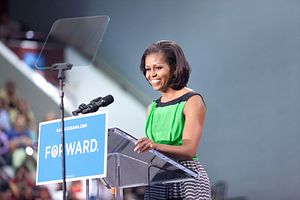At the invitation of China’s First Lady Peng Liyuan, her U.S. counterpart Michelle Obama is visiting China from March 19 to 26. This is Obama’s first visit to China, and also the first meeting between Obama and Peng. During the week-long trip, Obama will visit Beijing, Xi’an, and Chengdu, together with her two daughters. The White House said, Obama’s message on the trip will focus on education and cultural ties between the two countries.
Michelle Obama’s visit to China was announced after U.S. President Barack Obama’s trip to Asia in April, which will take in Japan, South Korea, Malaysia and the Philippines. Given this context, the first lady’s visit to China will send a powerful diplomatic message, even though she will steer clear of any political or hard issues.
First, the Obama administration hopes to send a clear message to China that the president’s April visit, and his rebalance to Asia in general, is not aimed at encircling China. Since its announcement in 2011, Obama’s rebalance to Asia is widely seen as a thin cover to balance, if not contain, China’s increasing influence in East Asia and the perceived assertiveness in its approaches to maritime disputes in the South and East China Seas. The problem with the rebalance, however, is that the Obama administration faces an uphill battle with budget constraints. To make matters worse, the government shutdown last year forced Obama to cancel his scheduled attendance at the APEC meeting and East Asia Summit in Southeast Asia, igniting serious doubts in East Asia about the credibility of the U.S. commitment to its rebalance to Asia. Obama’s April visit will be seeking to provide assurance to U.S. allies and friends in East Asia. But the dilemma of Obama’s rebalance to Asia is that it must reassure allies and friends of U.S. commitment, without causing serious concerns or suspicions from China. In that context, Michelle Obama’s weeklong trip to China may serve as a rebalance to her husband’s rebalance.
Second, the first lady’s focus on cultural ties and education will highlight the win-win relations between the two countries. More than 230,000 Chinese students were studying in the United States in the academic year 2012-2013, easily the largest group of foreign students. At the same time, nearly 20,000 U.S. students come to study in China each year, and the number is still on the rise. The educational links between the two countries serve as a bridge for people-to-people communication, facilitating understanding and benefiting both countries.
Third, the visit in a way makes up for Michelle Obama’s absence last year when Xi and Peng made an unofficial visit to Sunnylands, California at the invitation of the U.S. president. The first lady’s absence from the family meeting at Sunnylands was widely criticized by the media and even seen by some as a slight. Her China trip will reciprocate Peng’s visit and help build personal relations.
In addition to the first lady diplomacy, President Obama will meet President Xi Jinping on the sidelines of the coming Nuclear Security Summit in Hague, according to an announcement made by China’s Vice foreign minister Li Baodong. The two leaders will “exchange views on bilateral relations and issues of common interest.” Given the worsening crisis in Ukraine and the increasingly tense relations between Russia and the West, no doubt that topic will be on the table.
The message is clear enough: in a changing and increasingly uncertain world and at a time of embarrassing budget austerity, the U.S. does not want to alienate China. Rather, it needs partners like China to cope with the increasingly burdensome issues of regional and international security.
Wei Zongyou is Professor and Vice Dean of Institute of International and Diplomatic Affairs, Shanghai International Studies University, Shanghai, China. His main research interests cover Sino-U.S. Relations, American Foreign Policy, Humanitarian Intervention and R2P.

































